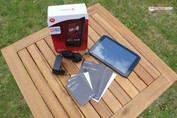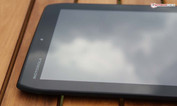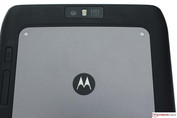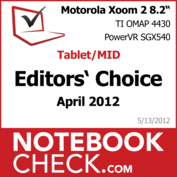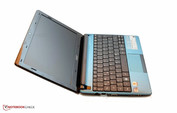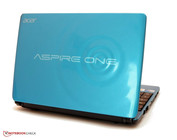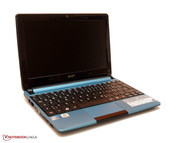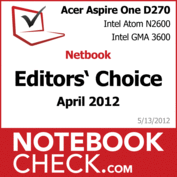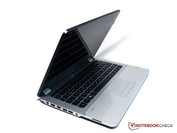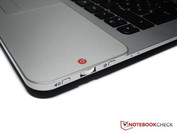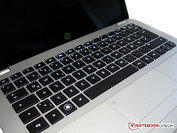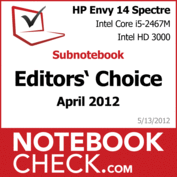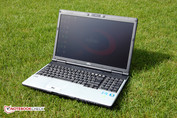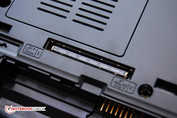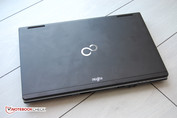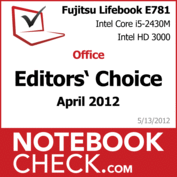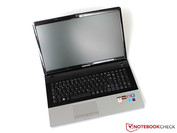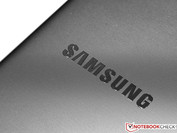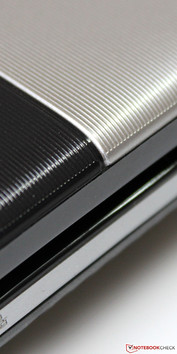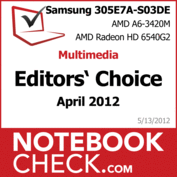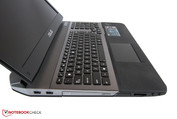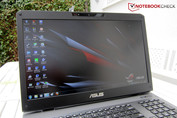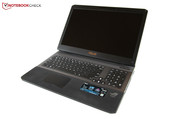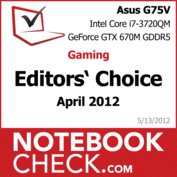Notebookcheck's Best of April 2012
April 2012 promised to be an exciting time of year. After months of rumors and half truths, Intel finally announced the start of the Ivy Bridge processor generation. We were able to obtain pre-launch test samples and were able to present in-depth reviews of the MSI GT70 (GeForce GTX 670M) and the Asus G75V (GTX 670M) gaming notebooks immediately after the Ivy launch on April 23rd.
Because we all had to wait for what seemed like forever for IVB to officially launch, we had reviewed several tablet computers, new ultrabooks and many multimedia devices with the old Sandy Bridge Cores during the downtime. We particularly liked the 14-inch Asus U44SG, which was nearly as thin as an Ultrabook despite the impressive Core i7 hardware.
In this monthly article, we summarize our April test samples and elect the best laptops in each category.
Tablet/MID
Contenders:
Motorola Xoom 2 MZ616 10.1-inch 86%
Motorola Xoom 2 MZ607 8.2-inch 86%
Gigabyte S1080 73%
The Motorola tablets are available in 8.2-inch and 10.1-inch models, each with Android 3.2 featuring OMAP 4430 processors. Therefore, it is hardly surprising that their ratings and prices are similar. The 8-inch model is about 50 € ($63 USD) more expensive than the 10-incher for a total of about 500 € ($636 USD). We liked the great build quality and the bright display that could also be used under sunlight. The battery life is around six hours, but could have been better, just like the mediocre camera. Advantage: Both Xoom 2 tablets have 3G functionality.
The tablet model from Acer is cheaper in comparison. Their Iconia Tab A200 has a standard 10.1-inch form factor with a slip-proof, rubberized case that feels comfortable on the hand. The Tegra 2 processor and Android 4.0 software allow for web browsing. The good battery life of nearly eight hours does not indicate that it is a budget tablet despite its low price. But, the low-resolution 2 Megapixel front camera and the low-contrast TN-display with narrow viewing angels unfortunately do.
Once again we reviewed another Windows based tablet PC. After Dell, HP, and Samsung, we got to know a bit more about the Gigabyte S1080. However, the (now outdated) Intel Atom N570 is too slow to run Windows 7 trouble-free, the display is too dark to work conveniently in natural lighting and the roaring fans are distracting. Considering the low performance, what has to be the interesting part? Well, if buying a tablet with Windows is a must, we recommend taking a look at the Latitude ST-LST01 (better display) or the Samsung Series 7 XE700T1A-H01DE (Intel Core CPU).
Tablet/MID of April 2012: Motorola Xoom 2 MZ 607 8.2-inch
Since both Xoom 2 tablets have the same rating, we elected the 8-inch Motorola Xoom 2 because of its handy size. Its sound is amazing for a tablet and the IPS panel displays strong colors. Still, the Retina panel of the Apple iPad 3 is still more impressive.
What we like
The case simply feels good and the Xoom 2's high-end screen is a treat for the eyes.
What we'd like to see
The internal memory's capacity is a bit tight. Moreover, no apps for managing media are preinstalled.
What surprises us
That the Xoom 2 ME amazingly produces so much sound. The sound experience is good for a tablet, even if it soon finds its limits.
The competition
Motorola's little tablet competes against its big brother, Xoom 2, as well as contenders from other manufacturers.
Netbook
Contenders:
Have netbooks been resurrected? After a long break, we reviewed three mini computers during April. The first one was the Acer Aspire One D270-26Dbb. The Cedarview-M Atom is nearly as slow as its predecessor and games are still a no-go for the new integrated graphics (Graphics Media Accelerator 3600). The advantage: The device is rather quiet with very low heat produced. The battery life of nearly 8:30 hours is not extraordinary in the netbook category and was already achievable by the previous generation of Atom processors.
The Asus Eee PC 1011CX is available for a similar low price of 299 Euro ($380 USD) in online stores. The name has changed, but not the look and the Cedarview-M performs still modest. The matte display stands out from the crowd with good overall brightness and a very high contrast. The battery life of nearly nine hours is also noteworthy. In this aspect, the white sister model Eee PC R052C-WHI002S (from 319 Euro or $400 USD) is on par: 8:53 hours in under the same wifi test. The R model even gets a more elegant case with chrome stripes. Otherwise, input devices, performance and connectivity options are identical.
Netbook of April 2012: Acer Aspire One D270
Because of its low power consumption, barely perceptible heat dissipation and the stable build quality, the Aspire One D270 takes a narrow lead. However, the three netbooks are worth a look as each have their own pros and cons. Here, the Asus Eee PC 1011CX's above average contrast could be the deal maker.
What we like
In particularly the high battery performance during load convinces us completely.
What we'd like to see
A fast USB 3.0 port would be state-of-the-art.
What surprises us
The fairly low system performance
The competition
Asus Eee PC 1015B netbook, Acer Aspire One 722-C52kk netbook, Asus Eee PC 1015PX netbook, Asus Eee PC R051PX, MSI Wind U270-E4523W7H, Samsung Chromebook Series 5, Asus Eee PC 1215B-SIV006M, Nokia Booklet 3G
Subnotebook
Contenders:
HP Envy 14 Spectre B1J92EA 87%
Lenovo ThinkPad X1 NWK3QGE 81%
Asus U44SG 87%
HP launched its 14-inch Envy 14 Spectre Ultrabook (model B1J92EA) in Germany a few weeks ago for 1.400 Euro ($1790 USD). The Spectre differentiates itself from the competition with a plane high-gloss lid and an Edge-to-Edge display. Although an eye catcher, the shiny features provide only decent contrast but heavy reflections when under natural lighting. Still, we like the high-end, robust build quality and the good battery life of up to five hours. Although the Low Voltage Core i5 is not a high-end processor, the 128 GB SSD accelerates the system noticeably. Unfortunately, HP decided to not include any IPS panel options with its premium Spectre models and, as a result, the viewing angles are narrow.
As for Sony, the Vaio VPC-SB4X9EB features mainstream performance (i5 Sandy Bridge, no SSD), good office capabilities (comfortable keyboard, matte panel) and high quality materials with a look not too different from the previous 2011 SB models. The Vaio still prefers a manual "Speed Mode" switch for activating the discrete AMD 6470M GPU, but our test unit experienced heavy throttling when under full load. Additionally, the discrete Radeon GPU is becoming rather weak for newer PC games.
Lenovo last month introduced its top model as part of the ThinkPad family, simply called the X1. We scrutinized the unit with an Intel Core i7 2640M for selling at an MSRP of nearly 1800 Euro ($2290 USD). The display is still reflective and shows entry-level performance in terms of contrast and viewing angles. In our opinion, the very high brightness should have been combined with a matte panel for better outdoor usability, especially for a notebook at this steep price range. Due to its high performance (i7, SSD) and premium high-end input devices, it can nonetheless be conveniently used in an office setting. Its Moderate battery life and subpar TN panel reduced its final scores rather noticeably here on Notebookcheck.
The Asus U44SG was a surprise. Final scores are good because of its bright and matte TN panel. The 14-incher features a fast Core i7 2640M with a 256 GB SSD, USB 3.0 and is hardly audible to boot. Gamers will consider the GeForce 610M rather ineffective as a gaming GPU, but we did like the long battery life of 8:32 hours in our wifi test and the great haptics of the matte and partly rubberized surfaces. Because of the low-contrast panel and limited connectivity options (no UMTS module, no dock), it just barely misses the mark for our "Very Good" score.
The Sony Vaio VPC-YB3V1E/S was the subnotebook with the lowest rating (79%) during the month of April. While still "Good" in our eyes, the rickety keyboard, few interfaces, low performance (AMD E-Series E-450) and dark display all prevented the Sony from scoring higher points. But, as with most Fusion-based notebooks, we were particularly fond of the low waste heat and even the weight.
Subnotebook of April 2012: HP Envy 14 Spectre B1J92EA
The April winner is the Envy 14 Spectre despite its low-grade display. The excellent backlit keyboard, low emissions and great looks swayed the pendulum towards HP's offering.
We should also give a worthy mention to the Asus U44SG as it scored the same final rating as the Spectre as well. It unfortunately includes a display that is average at best, but offers a matte solution with a faster Core i7 CPU for at least a couple hundred less than the HP Spectre.
What we like
The built-in keyboard is well-designed and is a pleasure to type on. The controls for the audio combined with the high-quality "beats-audio" speakers will satisfy multimedia fans.
What we'd like to see
The display should also be premium quality.
What surprises us
The Envy is not much different from a 13 inch Ultrabook (aside from its larger display). The price: thicker case, higher weight.
The competition
ASUS Zenbook UX31 Ultrabook (from 999 Euros), HP Folio 13-2000 Ultrabook (999 Euros), Dell XPS 13 Ultrabook (1499 Euros) or the Apple Macbook Air 13 (1400 Euros) and MacBook Pro 13.
Office
Contenders:
The Fujitsu Lifebook E781 turned out to be a worthwhile workhorse. Considering the "low" performance, the 15.6-incher is expensive (1,099 € or $1400 USD), but comes with plenty of professional equipment. We particularly liked the high-contrast display and the many interfaces including a docking port and a multi-bay slot for optional drives. The only points of critique are the selective high temperatures on the bottom and the permanent hard drive noise.
The US model of the HP Pavilion dm4-3090se is a stylish office companion with a backlit keyboard. Despite the mid-range Core i5 2450m, the performance is good because of the SSD cache. The matte display has, unfortunately, only a relatively low brightness and narrow viewing angles. German models do not feature an SSD cache and the resolution is reduced to only 1366x768 pixels. They do, however, feature a dedicated AMD HD 7470M.
Office notebook of April 2012: Fujitsu Lifebook E781
Fujitsu demonstrates how a good mobile everyday notebook for non-gamers can look like. The laptop fulfills nearly all requirements of demanding customers from UMTS module, high battery life to interfaces.
What we like
The bright display has great viewing angles and nice contrast. The connectivity is extensive.
What we'd like to see
A better cooling system and better speakers would make the laptop a much more attractive packet.
What surprises us
The way the manufacturer has understated the display.
The competition
This market segment contains a multitude of models, but if one takes into consideration the various ports and interfaces, then the closest competitors would be the Acer TravelMate 6595-2524G50Mikk and the Samsung Series 6 600B5B-S01DE.
Multimedia
Contenders:
Toshiba Satellite L755D-14U 77%
Packard Bell EasyNote LK11-BZ-080GE 75%
Samsung's 17.3-incher Series 3 305E7A-S03DE is a solid notebook but with small problems in terms of stability. For about $700, AMD's A-Series A6-3420M provides good performance thanks to its dual-graphics setup. However, serious players will be annoyed by the micro stuttering of the asymmetric graphics processing. In any case, the low system noise of the Samsung is outstanding.
Toshiba's Satellite L755D-14U is technically very similar. The 15.6-incher features a more modern HD 7540M, but due to the slow hard drive the system performance is worse than of Samsung's Series 3 305E7A. Furthermore, office users won't be interested in the Satellite L755D-14U for 700 Euro (~$900 USD) because of its elastic keyboard and sensitive surfaces.
If you are on a budget and want to own a 17-incher, you might consider the Packard Bell EasyNote LK11-BZ-080GE. It only features an AMD E-Series E-450 netbook processor for 499 Euro (~$650 USD) and can become a potential bottleneck in terms of performance, but the battery life of three hours is decent considering the screen size.
Multimedia notebook of April 2012: Samsung 305E7A-S03DE
The Samsung 305E7A achieves the best rating of the three rather weak laptops. The 17-incher is cheap and has enough power for modest players only. Office users will like the excellent keyboard and low system noise of the Samsung.
What we like
Energy-efficient and quiet: These advantages aren't a matter of course for a notebook with four processor cores and two graphics cards.
What we'd like to see
A somewhat more rigid case and a slightly brighter and viewing angle stable screen would improve the Office qualities of the 305E7A even more.
What surprises us
The micro-stutter issue is still unresolved even years after the introduction of SLI and crossfire.
The competition
Simple yet effective: The combination of Core i3 CPU and Radeon HD 7670M contributes to the good gaming performance of the Packard Bell F4311. If you prefer an AMD processor, you should take a closer look at the Llano notebooks, Acer Aspire 7560G or HP Pavilion 1353eg. However, they also struggle with crossfire issues.
Gaming/DTR
Contenders:
Asus G75V 88%
One M73-2N 83%
Five real gaming manufacturers with new hardware competed in our test parkour. The first one is the top gaming model from Asus: The Asus G75V tops the maximum laptop performance with its Core i7 3720QM Ivy Bridge processor, 256 GB SSD and HDD hybrid storage setup. The GeForce GTX 670M is quite high-end, but cannot keep up with current top gaming GPUs like GeForce GTX 675M or Radeon HD 6990M.
Asus demand a steep price of 2,300 € (~$2900 USD) for the highest-end model. As a result, the XMG P702 PRO from Schenker (barebones Clevo P170EM) can be a less expensive alternative for gamers. The 17.3-inch Schenker won't look or feel as good as the Asus above, but it is absolutely on par in in terms of performance for only 1800 Euro (~$2300 USD) for the Core i7 2670QM model. The GeForce GTX 675M can also run most games in full HD and we appreciate the matte display with wide viewing angles as well.
Schenker also offer its Ivy gamer in a 15.6 inch form factor: the XMG P502 PRO. The GeForce GTX 675M and i7 2670QM specs are identical to its larger sibling above, but the OCZ-Nocti SSD is a bit slower. Furthermore, it features a contrast-rich display, although we disliked the loud system noise and the rubberized touchpad.
MSI launched their first Ivy Bridge gaming notebook these last few weeks known as the GT70 (17.3 inch). Its price of 2.200 Euro (~$2800 USD) is steep and it does not even feature the strongest gaming GPU with the GeForce GTX 670M. Still, the two SSDs in RAID-0 and the i7 3610QM CPU both make the system extremely responsive and speedy in practically all tasks. The fullHD matte display impresses as well with its high contrast and wide viewing angles.
Although it uses an old Sandy Bridge CPU on a new chipset, the One M73-2N was still able to achieve 99 percent in system performance and 96 percent in graphics performance during our tests. The Core i7 2920XM, GeForce GTX 670M and Crucial RealSSD all make the high scores possible. Furthermore, the system experiences absolutely no CPU or GPU throttling when under extreme load. The price of 1200-1500 € or $1500-$1900 USD (depending on configuration) seems suspiciously low, so gamers will be getting a rickety keyboard made of cheap looking materials and a high noise level.
The Asus K93SM-YZ085V has the weakest performance as hardcore gamers will not be interested in the included GeForce GT 630M. Nevertheless, the 18.4-incher is quite heavy at 4.1kg (9.03 pounds). Its FHD display is unimpressive because of its low contrast and reflective nature.
Gaming/DTR notebook of April 2012: Asus G75V
The choice is easy. Asus has stuck to the advantages of the G series and has combined the high-end exterior qualities with extremely powerful inner hardware. In particular, the contrast-rich FHD display that supports 120 Hz (for Nvidia 3D content) deserves its rating of 92%. If, however, you are interested in the best performance per price, you should consider the XMG P702 PRO or P502 PRO from Schenker. These notebooks offer more performance for less money, but worse appearance and build quality compared to the Asus.
What we like
Such a good display is a rare pleasure.
What we'd like to see
A lower weight and better battery life.
What surprises us
Asus has improved all the right spots.
The competition
17 inch high-end models such as the Alienware M17x R3, the DevilTech Fragbook, the Medion Erazer X7813, the MSI GT780, the One M73-2N, the Samsung 700G7A, the Schenker XMG P702 PRO or the Toshiba Qosmio X770.


 Deutsch
Deutsch English
English Español
Español Français
Français Italiano
Italiano Nederlands
Nederlands Polski
Polski Português
Português Русский
Русский Türkçe
Türkçe Svenska
Svenska Chinese
Chinese Magyar
Magyar